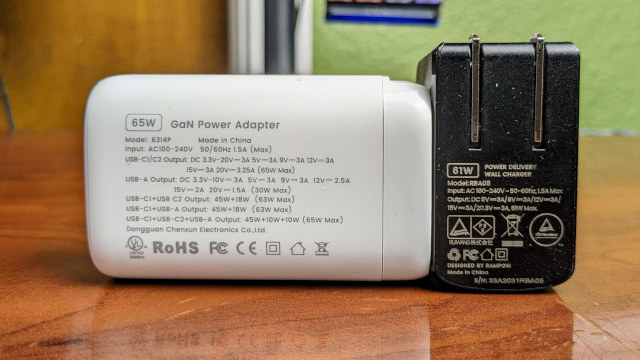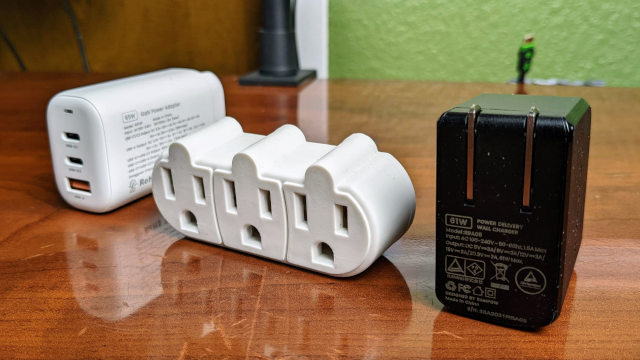What I Look For in a USB-C PD Charger
We were debating the merits of a tiny but somewhat expensive 40-watt USB-C charger over in the #deals channel earlier today. I thought it was a pretty nifty charger, because it really is ridiculously tiny, but we couldn’t learn much about it other than its size.
Some of the things we talked about made me think that I should collect my thoughts about USB chargers up and write them down in one place. This is that place!
I only look at GaN chargers
Gallium nitride (GaN) chargers aren’t really all that amazing. They will be smaller and lighter than traditional silicon chargers, but I don’t think they’re so small that they’re a real game-changer.
Even so, smaller and lighter is nice. Not only that, but everyone seems to be racing to make smaller GaN chargers. That is good for us!
The first thing I look at is price!
I don’t know why, but GaN chargers go on sale at ridiculously low prices. My first 61-watt GaN charger with a single USB-C port cost me less than $8. They don’t often go quite that low, but we have seen chargers with two or three ports for around $10 or $12.
Sure, that tiny 40-watt charger we saw on sale for $24 is cool! It is half the size of my $8 61-watt charger, and about might only be a quarter of the size of the 3-port 65-watt charger that I keep in my laptop bag, but it costs at least twice as much and 40 watts isn’t enough to charge my laptop.
I don’t plan to ever buy another phone charger
My single-port 61-watt charger was only $8, and it really isn’t all that much bigger than most of the old-school 5-volt chargers that shipped with all the phones and tablets that I have bought over the years.
I am not saving much money buying phone chargers that can’t charge my laptop, and I’m not saving much weight or space in my laptop bag. I look forward to the day when every USB charger around my house is capable of charging a laptop!
I like flip out AC adapter doodads!
I’m not convinced that these actually save space in my bag, but I enjoy when the prongs for the AC adapter can be flipped closed and hidden away.
For all I know they’d be able to slice half an inch off the bottom of my chargers if they didn’t include this feature. Sure, there would be prongs sticking out, but they’d probably take up less volume.
I don’t care. It is easier to neatly pack a brick in my laptop bag when it doesn’t have two prongs sticking out.
Make sure your charger supports the voltages you need!
It would be even better to make sure your charger supports every single voltage in the USB-C PD specification!
One of our friends on the *Butter, What?! Discord server told us that he doesn’t buy a charger unless it specifically lists the supported voltages in the description. This is one of the things we don’t like about that tiny 40-watt charger–it doesn’t specify any voltages!
He had a charger that skipped the 12-volt support. That means some devices either won’t work or will charge slowly when using them with his charger.
I like nice big labels with voltage and port specifications!
I didn’t know how much I wanted this until today. If you’re making sure you buy chargers that support all voltages, this might be less important. If you’re like me, though, you won’t know for sure in three years which voltages your charger actually supports.

Not only that, but maximum output per port varies depending on which ports you are using. The one I have in my hand can charge my laptop at 65 watts, but if I plug my phone into another port, the 65-watt port will drop to a maximum of 45 watts.
The charger I keep in my laptop bag has a huge banner on one side with a list of supported voltages and per-port wattage limitations. It is fantastic.
All chargers are required to print the supported voltages and maximum amp ratings on the charger, but they are not required to print the output of each USB port.
Do I have to worry about a cheap charger burning out my $3,000 computer?!
Maybe. Your chances of getting killed by a cow are low, but never zero.
Your $3,000 computer has circuitry to prevent this sort of thing from happening. Even the absolutely worst charger manufacturer is at least trying to output the correct voltage.
Chance > 0
I don’t have any real statistics or science. About all I can say is that I haven’t had any friends tell me a story of a rogue power brick burning out their laptop. I am sure there are instances documented on the Internet, and I am sure it is possible.
What about 90-watt, 100-watt, and 150-watt USB-C chargers?!
I am as surprised as you are that I’m not hunting for deals on huge USB-C chargers. My last two laptops both required massive 140-watt power bricks. I’m excited that if I ever need a ridiculously beefy laptop again that USB-C charging will be an option.
I might eat my words in a few years if I decide to replace my efficient 2-pound 14” 2-in-1 laptop, but I think I’ll be happy with 65-watt chargers sprinkled around the house for quite a long time.
Even if I buy a massive laptop again that runs of a gargantuan charger, I would still be able to top its battery off overnight with one of my many 65-watt USB-C chargers.
If you need bigger chargers, then you should buy bigger chargers!
What about the crazy chargers with AC outlets?!
Over on the #deals channel on our Discord server, we think these 4-port GaN chargers with AC outlets are pretty neat! Wouldn’t this be handy at an airport when you need to share an outlet that is already in use?!
This thing is $60 at full price, but it happened to be 20% off when I went to grab a link to put in this blog. Even at $48, I’m not sure it is a good deal.
I’ve been carrying 3-way AC splitters in my bag for years. You can get them for a buck at the Dollar Tree. Sometimes I pick up a handful of green ones at a random store after Christmas. These let me share an outlet and plug my own $8 USB-C charger in.

I keep buying new splitters because I keep leaving them behind. They only cost a dollar, so you may as well let your new friends at the airport keep charging when you leave. Maybe you needed one more outlet to plug in the old Wii at the makerspace, or you needed an extra USB charger to plug a Google Mini in on your nightstand.
These cheap splitters are one of the handiest things I’ve ever carried in my bag. I hope it goes without saying that you shouldn’t plug things like refrigerators and heaters into these cheap splitters. Lights and laptops are fine.
Even expensive chargers are cheap! Does any of this matter?!
I don’t feel like this is one of those situations where less is more. I want more chargers. So many more chargers!
I want at least one charger in every laptop bag. I want one charger on every wall or desk in my home office. I want one in every room of the house.
I don’t want to feel bummed out that I left a $70 charger in a hotel room. If I let somebody at the makerspace top off their battery with my charger, I don’t want to have to worry about collecting it when I have to leave. It is no big deal if I don’t get my $12 laptop charger back.
Conclusion
I don’t know if there’s a conclusion. This just seemed like useful information to write down.
I think the most important thing I had to say in this blog is that those 3-way AC splitter doodads are one of the best things you can carry in your bag.
What do you think? Have you had an inexpensive charger fry your gear? Or are you using chargers that go on sale for less than $15 all over the place like I am? Do you prefer fancy USB-C PD chargers? Let me know in the comments, or stop by the Butter, What?! Discord server to chat with us about it!